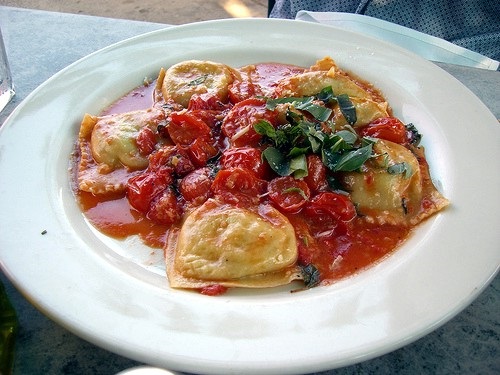Difference between Marinara and pizza sauce
Tomato Sauce: As You Like It
When it comes to sauces based on tomatoes, you can find as many recipes and variations as sand corns on a beach. You can find recipes for “original” marinara sauce on websites in California, Egypt, and India. As varied as the recipes for “marinara” are the recipes for pizza sauce. With or without garlic, with or without onions, with cinnamon, chilies, or black pepper, everything goes. Guess what? The spices make all the difference, and they vary from culture to culture. What remains in the end from the original is questionable. But then again: As long as it tastes good, who cares?
The really original marinara sauce exists, of course. Like many Italian classics, it originates in Naples, south of Rome, where people are poor, honor requires killing, and mamas serve opulent plates of pasta. One thing is for sure. There was no marinara sauce before the mid 16th century, when Spaniards introduced the tomato to Europe. However, the Italians adopted this new ingredient quickly. The Italian Chef Antonio Latini was the first to publish a recipe for tomato sauce in his cookbook Lo Scalco alla Moderna, published in two volumes in 1692 and 1694. Since then, the tomato sauce has evolved into many variations.
The mariner’s wife edition—mariner’s wife is the literal translation of marinara—came into being in Naples. When exactly, that remains obscure. What can be said for sure is that a marinara sauce that resembles the Italian original has rather less than more ingredients. A bit of onion and garlic, plenty of tinned tomatoes, basil and/or oregano and/or thyme and olive oil are the main ingredients for an Italian-style marinara sauce. Tinned, not fresh tomatoes—many Italians swear that they taste a lot better in a sauce than fresh ones.
As the origins of the marinara sauce, so remain the origins of the real pizza—somewhat murky. It seems for sure that people in Naples enjoyed flatbread topped with tomato sauce and various other things by the late 18th century. Until today, there exist pizzerias in Naples who serve only two kinds: the “marinara” and the “margherita.” The marinara is made with oregano scented marinara sauce of course, while the margherita, invented in 1889 in honor of Queen Margherita of Savoy, is graced by tomato sauce, mozzarella, and fresh basil.
Is there a difference between marinara and pizza sauce? Yes and no. Marinara sauce makes a perfect topping for any kind of pizza. Yet some people prefer to spread simple, double -concentrated tomato puree on top of their pizzas. This tomato puree is available in tetra packs all over the world and can be used on any pizza as is. It has the advantage to deliver only the taste of tomatoes and not to interfere with the taste of the other toppings. It has the added advantage not to require any cooking.
On the other hand, many people prefer to top their pizza with a tomato sauce that boosts many flavors, especially in the USA. One of the hallmarks of American cooking is the use of many different spices together, according to the guideline: the more, the better. These people are well advised to use a specially prepared pizza sauce. Like any tomato sauce, it can be easily cooked at home or bought in many variations in any supermarket. Remember: It has to taste good; that’s all that matters.
Recipe for Marinara Sauce:
Ingredients:
- 6 tablespoons extra virgin olive oil
- 1 medium, diced red onion
- 4 cloves garlic, crushed
- 2 teaspoons dried oregano or basil or thyme or all
- 1 big tin of tomatoes from Italy
- 1 tablespoon sugar
- Salt and pepper to taste
Method:
Heat oil in a saucepan. Fry onions and garlic over medium heat for about two minutes until onions are translucent. Add the herbs, the tomatoes, and the sugar. Bring to a boil and then lower to a light simmer, stirring occasionally for 30 minutes. Season with salt and pepper.
Recipe for Pizza Sauce:
Ingredients:
- 4 tablespoons extra virgin olive oil
- 3 cloves garlic
- 1 big tin of tomatoes from Italy
- 1 tablespoon sugar
- Any herb you fancy
- Salt and pepper to taste
Method:
Heat oil in a saucepan. Add the onions, the spices, and the crushed garlic cloves. Stir well, bring to a boil, and simmer on a low flame for 10 minutes. Season with salt and pepper.
- Difference Be Garam and Tandoori - February 29, 2016
- Difference Between Pasta sauce and pizza sauce - February 23, 2016
- Difference between Marinara and pizza sauce - February 23, 2016
Search DifferenceBetween.net :
 Email This Post
: If you like this article or our site. Please spread the word. Share it with your friends/family.
Email This Post
: If you like this article or our site. Please spread the word. Share it with your friends/family.
1 Comment
Leave a Response
References :
[0]http://www.littlespicejar.com/homemade-pizza-sauce/
[1]http://www.food.com/recipe/authentic-italian-marinara-sauce-446687
[2]http://www.passion-4-pizza.com/history_of_pizza.html
[3]https://en.wikibooks.org/wiki/Cookbook:Marinara_Sauce
[4]http://www.lifeinitaly.com/food/pizza-history.asp
[5]https://en.wikipedia.org/wiki/Marinara_sauce



In the pizza sauce recipe, when are you supposed to add the tomatoes, sugar, and any herb you fancy?